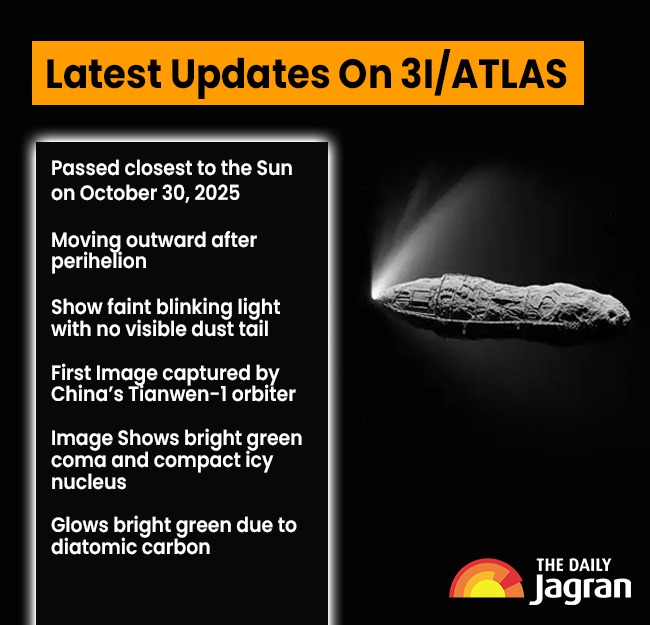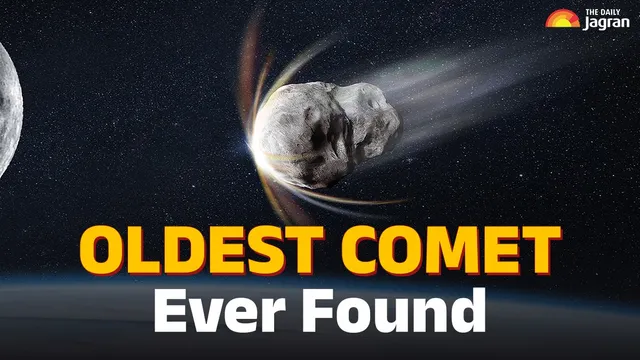- By Supratik Das
- Mon, 10 Nov 2025 04:46 PM (IST)
- Source:JND
Oldest Interstellar object: In a discovery that has stunned astronomers across the globe, NASA scientists have confirmed that the interstellar comet 3I/ATLAS, now passing through our solar system, is older than the Sun itself. Estimated to be around seven billion years old, this ancient traveler from another star system has revealed rare signs of water activity, a shifting green hue, and even a mysterious loss of its tail after reappearing from behind the Sun.
Visitor Older Than Our Solar System
Comet 3I/ATLAS was discovered on July 1, 2025, by the NASA's Asteroid Terrestrial-impact Last Alert System telescope in Chile. It is the third known interstellar visitor to travel through our solar system, after ʻOumuamua in 2017 and 2I/Borisov in 2019.
In contrast to all other comets that orbit the Sun in elliptical or parabolic trajectories, 3I/ATLAS follows a hyperbolic path, meaning it came from deep interstellar space and will soon leave our solar system forever. According to NASA's Center for Near-Earth Object Studies, the trajectory of this object is confirmed to originate from outside our solar system, representing a rare opportunity to study pre-planetary material.
Recommended For You
A major breakthrough came when NASA's Neil Gehrels Swift Observatory detected faint ultraviolet signals around the comet, a clear sign of hydroxyl gas produced when sunlight breaks apart water molecules. This confirmed active water sublimation even at distances where ice should remain frozen.
Researchers estimate that the comet is losing about 40 kilograms of water every second, which implies that its icy core is highly active. "This object behaves like a cosmic time capsule, carrying pristine material from before our Sun was born," said Dr. Zexi Xing, lead scientist from Auburn University.
-1762773539062.jpeg)
Alien Buzz And Scientific Significance
As with its predecessor ʻOumuamua, online speculation about alien technology quickly followed the comet's unusual behavior. Some scientists, including Harvard's Avi Loeb, have suggested its erratic path could hint at an artificial origin. However, NASA and ESA maintain that 3I/ATLAS is wholly natural-a remnant of another star system's formation process.
In early November, 3I/ATLAS reappeared from behind the Sun with a bright green coma but no visible tail, puzzling astronomers. Observations from the Sabadell Observatory in Spain and Lowell Observatory in Arizona showed that the tail hadn't disappeared; it was aligned directly away from Earth, making it nearly invisible.
The green glow comes from diatomic carbon (C₂), molecules that emit green light when broken apart by ultraviolet radiation. "It's a textbook example of solar chemistry in action," said astronomer Qicheng Zhang. "The Sun's UV rays are effectively burning the comet's surface, giving it that eerie emerald color."
How And When To Watch
The comet will be visible in the eastern pre-dawn sky through November and December. Skywatchers can look for it near Venus and the bright star Spica in the constellation Virgo.
• Best Time: Around 4–5 AM local time
• Equipment: A small telescope or strong binoculars
• Closest Approach To Earth: December 19, 2025, at about 270 million kilometers

To scientists, 3I/ATLAS is more than an enigmatic visitor; it's a messenger from a time before our Sun existed, carrying the chemical fingerprints of a bygone era. For the rest of us, it’s a once-in-a-lifetime chance to glimpse a 7-billion-year-old wanderer from the stars.





